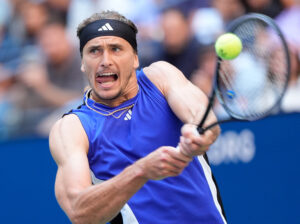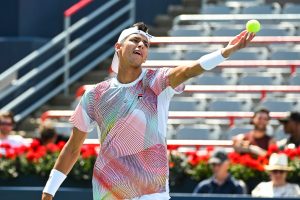Daniil Medvedev is a player on the rise. A member of the “NextGen,” Medvedev won his biggest tournament last November at the season ending World Tour finals in London. He also became the first player to defeat the top 3 seeds to win the ATP Finals, which is a great achievement.
This year Medvedev has risen to #2 in the ATP rankings and reached the final of the Australian Open. Medvedev also had reasonable results in the spring, making the quarterfinal of the French Open and 4th round of Wimbledon. At the French he lost to Sefanos Tsitsipas in straight sets and he fell to Hubert Hurkacz in five sets at Wimbledon.
Medvedev has an unorthodox and intriguing game style which is definitely worth looking at in some depth.
Daniil Medvedev: Breaking down his game
Serve
Medvedev is the latest in a long line of very tall professional tennis players. Since the start of the 1990s there has been a sharp increase of players 6’4″ or taller (1.95 meters). In the 1990s players like Todd Martin, Michael Stich, Mark Philippoussis, Richard Krajicek, and Goran Ivanisevic stood tall. The 2000s saw Marat Safin, Ivo Karlovic, Max Myrni, Juan Martin Del Potro and John Isner. These guys have one thing in common–they serve hard and serve very well! Medvedev comes into this category. Other players from this generation who are very tall and serve big include Alexander Zverev, Nick Kyrgios, and Taylor Fritz.
Being that tall gives advantages over shorter players when it comes to placing the ball in the corners. Medvedev is a throwback; he has a fairly simple service motion with not much knee bend. He can produce upwards of 220kph (135 mph) and regularly hit first serves between 170 kph to 210 kph (110 to 130mph) consistently.
Medvedev initially places his racquet at a perpendicular angle, giving the impression he will serve with a backhand grip. However, I get the impression he uses a continental grip. He also brings the racquet down first in his service motion as he tosses the ball up This is a classic way of serving; other modern players open up their bodies more and have the racquet up as they toss the ball. Medvedev uses a motion which is a relaxed and technically should not break down under pressure. He can use his second serve as a weapon to get cheap points or with a lot of spin.
ATP stats show Medvedev wins 75% of his first serves throughout the year, and 52% of his second serves. In my opinion, 75% is good but he should look to raise that to 80%. If he wants to become a champion at grand slam level. 52% of points won on his second serve is not bad, but again, he should be looking at 55 to 60%. How Medvedev achieves this will be a task he needs to discuss with his coach; working out strategy and shot selection after certain serve patterns.
The serve I like most by Medvedev is the slice serve on the ad court to the forehand. I have said this for many years, this is an underused serve in the modern game. The returner is not challenged as much as he should be. Medvedev is able to serve the ball away from the returner’s forehand on the ad court at pace (192kph plus). Currently, too many players angle the ball into the returner’s forehand, making them look good.
The technique of using slice to move the ball away from the forehand is a throwback serve, a serve that elevated Pete Sampras and Serena Williams to a different level. It is nice to see Medvedev use this method as opposed to standing further from the centre line and being forced to use sidespin as a result. Technically, definitely old school.
Return of Serve
Daniil Medvedev has one of the best return of serves on the ATP Tour right now. On average, Medvedev converts 40% of break points which is incredibly high and very impressive. If he can raise his first serve points won to 80% that would propel him to #1 in the world. Medvedev uses a few different strategies throughout the course of matches, making him a little unpredictable.
Medvedev treats tennis like a game of chess, making moves on his opponents when they least expect it. Including taking the ball early and approaching the net, or standing as far back as possible near the backboard. This is a very modern method and Medvedev can be vulnerable to the player who can serve into the corners and take the net away. Ironically, Medvedev used that tactic in the ATP Finals final against Dominic Thiem with serve volley plays. As Thiem was often standing near the backboard to return serve.
Medvedev’s two-handed backhand is reliable, and like Todd Martin back in the 1990s, can use his height at 6 ft 6 to really lean on the ball and punish it. It is difficult to hit consistent kick serves on a guy as tall as Medvedev, the body serve would be more effective. Medvedev uses an extreme grip on the forehand so should have more trouble there, it is often a trade off that players who use the extreme western forehand grip will have more issues there on the return.
Even though Medvedev has great stats on the return of serve, we have yet to really see him on grass and clay on a consistent basis. Like so many modern players, Medvedev’s game is built for hard courts where the bounce is even and it is always possible to look good. As of now, Medvedev’s stats on clay do not look too clever and the natural surfaces require more out of you. Medvedev has a thinking man’s game so I don’t see why he can’t win titles on clay as long as he works on it. Grass will be interesting because of his forehand grip but let’s see how his career develops.
Forehand
This is the shot which I find interesting in Medvedev’s game. He is not the first top level player to use an extreme forehand grip. My mind goes back to Alberto Berasategui, who reached the 1994 French Open final. Amelie Mauresmo came through in the late 1990s with an extreme western forehand. Despite that, Amelie became one of the great grass court players of her generation.
Therefore, having an extreme western grip doesn’t condemn you to obscurity, but it does make life more difficult! Clearly this is the path Medvedev has chosen at a young age and he has to stick with it for his career. Commentator and former British #1 Tim Henman consistently says that Medvedev hits the forehand “flat” and much lower over the net than most of his contemporaries.
This is true. It is fair to say Medvedev hits on average with less loop on the forehand side. This is slightly surprising as players associated with an extreme western forehand grip tend to hit with more spin and higher net clearance. Once again showing what an unorthodox player Medvedev is. In his case, the phrase “flattening it out” to hit winners doesn’t apply. Primarily because he takes that approach at all times and is trying to hit as many winners as possible.
I would not call Medvedev’s forehand a typical rallying shot. He generates tremendous pace and likes to use the inside out forehand to force his opponent back and close the net. This is a tactic which is underused in men’s tennis over the last twenty years. Many players have become risk averse and play too safe–prepared to hit 30 shot rallies instead of forcing the initiative.
Medvedev does not have the nicest looking forehand we have seen. That technique could cause an injury somewhere down the line but it works for him. It will be more difficult to return serves with that grip on grass as the ball skids more. Though grass bounces higher than in the past it is still a natural surface, does not bounce evenly like hardcourts and requires more adjustments. Clay requires more topspin so consistent low net clearance will definitely be an issue. Especially when it comes to defending your position behind the baseline. Ten of Medvedev’s 11 titles so far have come on hardcourt.
Backhand
If Medvedev’s forehand takes getting used to from a visual standpoint, Medvedev’s backhand is a very nice-looking and effective shot.
Medvedev has what I would call a classic two-handed backhand. Due to his height, he tends to hit with the closed stance as opposed to the semi open stance. Medvedev steps into the shot a lot more, planting the left foot forward and turning his shoulder into the shot.
American commentators like Leif Shiras call that approach “leaning on the ball”. Meaning, Medvedev can really use that to hurt his opponent. The key is to step into the shot for that to be effective. Also, at 6’6″, the high ball shouldn’t trouble him as much as it might do other players with either a one-hander or two-hander. Many two-handers also struggle with the ball up high.
As with Medvedev’s forehand, his backhands are hit quite low over the net. Again, this is a little surprising and quite a risky play but it is Medvedev’s game so he has to make the best of it. Keeping the ball low can rush the opponent, however it can be risky and lead to more errors. From what I can see, despite the low net clearance, Medvedev’s backhand in the rally is a safe shot.
Due to the fact Medvedev’s game is so hardcourt centric, we have yet to really see him consistently on the natural surfaces to make a long-term assessment on his backhand. On indoor hard court at the ATP Finals against Thiem, Medvedev used the slice backhand a lot. Playing Thiem at his own game. Thiem used the slice backhand to stay in the point, as opposed to using it to get a good position at the net.
Therefore, Thiem’s strategy was not really effective. If you are going to hit lots of slices, you need to do something with it. Medvedev was happy to trade slices to avoid having to hit up. This demonstrates that Medvedev is prepared to play any strategy that helps him to win a tennis match.
Net Play
Daniil Medvedev does not have the best technique on the volley. It is perhaps above average but by no means top notch in terms of technical aspects. However, that is immaterial if it gets the job done. What is impressive is how often Medvedev is willing to go to net throughout the course of his matches.
A player that I can think of from past decades would be Jimmy Connors. Connors was a specialist baseliner who along with Bjorn Borg and Chris Evert helped to change the game in the 1970s. Even though Connors was a baseliner, he went to net more in his matches than many serve volleyers.
Medvedev is very similar. In the ATP Finals against Thiem, Medvedev went to net 37 times and won 28 points, which is an excellent conversion rate. In contrast Thiem went to net 21 times and won 14 points. That indicates Medvedev was the one trying to dictate play. Medvedev, on return of serve, would take the ball early and come to net to finish points. Good old-fashioned hustle play which is nice to see.
Daniil Medvedev can improve his volleys further by making sure his arm is always out in front and take the ball early with slice, he is getting there. He also hit some impressive low volleys for such a tall player which shows he is flexible and has good movement.
Movement
Medvedev has excellent movement for a player as tall as he is. Medvedev is lean and doesn’t carry any excess weight which helps. It is true to say in the past, very tall tennis players didn’t move around the court as well but that trend may be shifting slightly with Medvedev who is good at coming forward. He has to be careful about getting backed up too far behind the baseline which will not help his overall mission to win hundreds of tennis matches throughout his career.
The only other players who were 6 ft 5 plus and moved extremely well along the baseline were Marat Safin and Richard Kraijeck. Krajicek was a serve volley specialist but moved very well in the baseline rallies. Del Potro is a great player but doesn’t move quite as well as Medvedev. Medvedev has the advantage on other tall players Alexander Zverev and Taylor Fritz.
Different Surfaces
Daniil Medvedev had a reasonable spring season in 2021, reaching the quarterfinal of the French Open and the 4th of Wimbledon. He also won his first grass title in Mallorca, a new tournament at ATP 250 level.
However, I am sure Medvedev would be disappointed he didn’t do better in the majors. This is by far his best showing to date. At the same time, he is now #2 in the world and expects more from himself.
I was at Wimbledon in Court 2 for his match against Hubert Hurkacz. I got to see his game close up over a two-hour period. The only way Medvedev can become a consistent contender is by hitting with higher net clearance consistently. We are not talking moonballs but he does need more topspin. His game is too high risk. High risk in the sense that errors and frustration will always be around the corner. Medvedev has an excellent serve on grass and clay, if he can come up with a good back up game, he can become a contender. Like so many modern players, his game is too hardcourt centric.
Summary
Daniil Medvedev has the opportunity in the next two to three years to make a name for himself and win a major title and fulfil the promise of the “next gen” crop There will be a scramble to see which player age 25 and under will be the first to do it. Medvedev has as good a chance as any and has an interesting game, doing things on the court other players don’t or can’t. Medvedev’s task is to elevate himself from an all-court player specializing on hard courts to an all-surface player–that’s where he can become a household name.
Main Photo from Getty.






